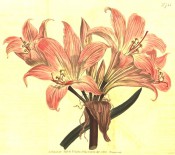Amaryllis belladonna L.
A frost-hardy, deciduous, bulbous perennial, the leaves evenly spreading or sub-erect, in a basal cluster, usually narrowly strap-shaped, sometimes broader, tapering towards the end, with a prominent midrib. Inflorescence a spreading, somewhat one-sided, umbel on an erect scape, appearing before the leaves, the flowers trumpet-shaped, the pedicels shorter than the perianth, elongating when fruiting. Stout purple or purple-green spathes, often exceeding 60cm tall, bear umbels of 6 or more funnel-shaped, scented flowers in autumn. It is a highly variable species in the wild, in width and length of leaves, in circumference, colour and height of scape, but particularly in flower colour, which, although usually pink, ranges from white to almost red. There are several named garden forms. [RHSE, Hortus, Baker Am.].
Horticultural & Botanical History
First published as Amaryllis belladonna by Linnaeus in 1753 [Sp.Pl. p293/1753]. Unfortunately Linnaeus had previously named a South American plant, a species of Hippeastrum as Amaryllis, the cause of controversy and confusion for the next 200 years or more. A number of alternatives names were proposed over the two centuries, hence the large number of synonyms, but an exception to the Principle of Priority has been made for this plant and Amaryllis belladonna is now the accepted name. Confusion does still occur, and as recently as 2006 I visited an orchid nursery, and in talking to the owner learnt that he had begun hybridising Amaryllis, which greatly interested me. However, the seeds he showed me were obviously Hippeastrum.
‘This showy and truly splendid bulb has, I fear, not been treated with the attention which its merits as a late autumn-flowering bulb deserves. It is true that we may here and there see a few imported plants of it in pots, decorating the greenhouse or conservatory at this season, but they afford but a poor idea of the gorgeous flowers which the lily produces when cultivated out of doors’. [Gard. Chron. 1849]. In contrast to Britain it is a very common garden plant in Australia.
Early descriptions of Amaryllis belladonna L. often confuse the type species of Linnaeus, from South Africa, and Hippeastrum species from the Americas, also called Amaryllis by Linnaeus. One of the earliest coloured figures is in Curtis’s Botanical Magazine, and, although the description and figure are of A. belladonna L., much of the text refers to Hippeastrum species. [BM t.733/1804].
The variety pallida, varying from the type only in its paler flowers, is figured in the Botanical Register. [BR f.714/1823].
Flore des Serres figures Amaryllis belladonna rubra, raised by the celebrated Ghent nurseryman Louis van Houtte, with bright pink flowers with a white throat and paler tube. This variety is particularly hardy in northern Europe and is probably the variety later used in hybridisation experiments with Brunsvigia species in Holland. [FS f.1415/1859]. A. belladonna purpurascens is also figured. [FS f.911/1853-54].
Introduced to Britain in 1712. [Baker Am.]. IH pl.228/1859.
History at Camden Park
An early introduction to Camden Park it was recorded as received per ‘Sovereign’ in February 1831, [MP A2948], but may have been present much earlier. Listed in all published catalogues [B.35/1843]. Forms of A. belladonna are still present in the gardens in large numbers but most show unmistable signs of hybridity and many are superb examples of x Amarygia parkeri, which see.
Notes
Published Jan 13, 2009 - 05:20 PM | Last updated Jun 20, 2012 - 04:31 PM
| Family | Amaryllidaceae |
|---|---|
| Category | |
| Region of origin | South Africa |
| Synonyms |
|
| Common Name | Belladonna lily, Naked lady |
| Name in the Camden Park Record | Amaryllis belladonna
|
| Confidence level | high |


